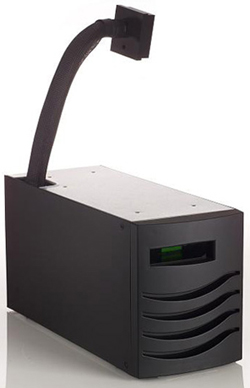Watercooling is a great alternative to
air, but it does have its drawbacks. With a standard watercooled
system, temperatures will never go below ambient levels. This is where phase
change cooling comes in. Phase Change cooling is still somewhat of a fringe technology, mainly because of the expense, and
modifications that a user needs to make to their system before it can
be used. However, it will cool a processor to below ambient temperatures, and this
appeals to the zest for overclockabilty of many an enthusiast.
How does Phase Change cooling work?
 Phase change cooling
works on the same principle as a refrigerator. A compressor is used to change the
state of a chemical refridgerant from liquid to vapour, and as this happens an endothermic reaction occurs where
heat is absorbed causing the temperature to drop.
Phase change cooling
works on the same principle as a refrigerator. A compressor is used to change the
state of a chemical refridgerant from liquid to vapour, and as this happens an endothermic reaction occurs where
heat is absorbed causing the temperature to drop.
The system essentially works like
this; the compressor compresses a gaseous refridgerant which causes it to
rise in temperature. The refridgerant, still in gaseous form and under high pressure, is sent to the
condenser (a heat exchanger) where it is cooled down and condenses into a liquid (this is the
phase change that occurs). The now liquid refridgerant is forced at high pressure through copper capillary
tubing into an evaporator chamber which is a low pressure area, and evaporates back into gaseous form, absorbing heat
in an endothermic reaction (it gets very cold).
The evaporator chamber in a phase
change cooling system just happens to be the block of copper which is attached to
the CPU, so as the chamber decreases in temperature, it absorbs the heat energy from the
processor below, lowering its overall temperature as well.
The refridgerant now in gaseous form once again, moves back
through the compressor, and the entire cooling cycle repeats.
The first commercially available PC phase
change cooler was built by Kryotech in 1996. The company never really
succeeded as they only sold
complete 'supercharged' AMD K6-2 systems. There was no option to just by the phase change
cooler and use it on an Intel or AMD platform - which didn't present much of
a draw for the emerging class of Celeron 300A overclocking enthusiasts. It would not be
until Asetek released their Vapochill in 1998, that phase change started to appeal
to overclockers.
The original Vapochill SE phase change
cooler could handle a 100W heat load while maintaining -10 degrees
Celsius temperatures. Best of all, enthusiasts were able to just by the cooler
itself... this set the standard for the industry. As we fast forward to the present day, the
most powerful systems available are Asetek's Vapochill LS and Nventiv's Mach II GT, both of which have
many times more the cooling ability than the first Vapochill.
In the following tests to see how
overclocking is affected by cooling, we'll be testing with an Nventiv Mach I
phase change cooler. An old system by all accounts, this unit
has had its R134a refridgerant professional removed (at a
cost of about $200CDN), and replaced with R404A coolant which
has a lower evaporation temperature. That translates into a -10 to -15 degree Celsius cooling
advantage, or basically -45 degrees Celsius cooling. :-)
The biggest drawback to adopting a phase
change cooling system such as the Nventiv Mach I is the cost...
about $650 CDN ($500 US)! That's equivalent to the price
of a small computer, and considering this is just the cooling system, it just doesn't make sense for
most consumers. What's more, top of the line phase change coolers are even more expensive, ranging in price from $1100
CDN ($822 US) for a Vapochill LS to $1700 CDN ($1225 US) for a Nventive Mach II GT.
